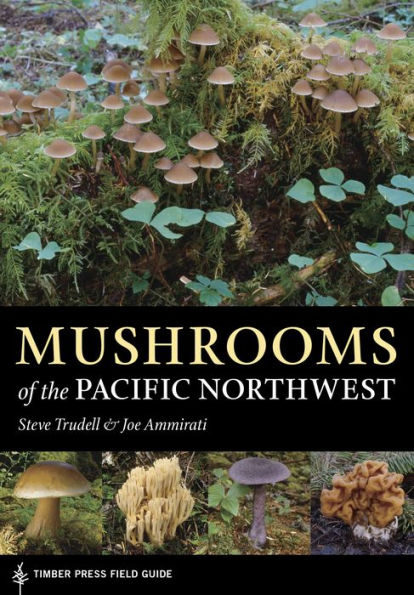Read an Excerpt
Preface Generally speaking, the Pacific Northwest (PNW) encompasses all of Oregon, Idaho, and Washington, plus portions of northern California, western Montana, southern Alaska, and southern British Columbia (B.C.), Canada. The most characteristic part of the PNW biological region, however, lies north of a line that roughly coincides with the 44th parallel of latitude, extending eastward from Florence to Springfield/Eugene to Bend to Ontario, Oregon, and then through Boise to Idaho Falls, Idaho. The northern limit is in southern B.C. and Alaska at the transition to the boreal forest region. For most people, the PNW evokes images of towering trees festooned with lichens and clubmosses, dripping from the seemingly incessant rain. However, this picture is not complete without an assortment of mushrooms decorating the forest floor for anyone who takes time to look down. Mushrooms, as we broadly define them, represent numerous small to large, conspicuous fungi that have evolved an array of different forms and colors. They occur as decomposers, living on dead organic materials, and as symbionts with plants, animals, and other fungi. Because of these lifestyles, mushrooms play major roles in the functioning of ecosystems where they provide nutrients to trees and other plants, recycle those nutrients by breaking down wood and other plant materials, and cause damage as plant pathogens. Many species have intercontinental distributions across the Northern Hemisphere, others occur at the continental or regional scale, a smaller number are more localized, and some have global distributions. Where fungus species occur today reflects a complex of interactions with other organisms and the physical environment over time. Temperature, moisture, soil, topography, vegetation, and other factors influence where fungi grow, when they produce their fruitbodies, and how their spores are dispersed from one location to another. People from many cultures have long histories of gathering mushrooms for food, medicine, and mind-altering effects and, in the process, also have accumulated considerable knowledge about poisonous and deadly species. In addition, mushrooms have been used for a variety of other purposes, including tinder, dyes, clothing, and decoration in the form of illustrations, carvings, and icons. The use of mushrooms by peoples in diverse cultures invariably has involved some system of names to facilitate acquiring and exchanging information about them. While almost all cultures have developed a system of common names for their most notable edible and poisonous mushrooms, none have assigned names to all mushrooms, so the overwhelming majority have no common names. Beginning around the late 1700s, mushrooms began to be studied, given scientific names, and arranged in classification schemes. That activity continues today, and gradually many fungi for which there were no previous names have been given scientific names. For identification purposes, it is better to use these names so that communication within and across cultures and societies is as precise and effective as possible. Mushroom-hunting has always had a certain number of devotees, but it has become increasingly popular over the past 50 or so years, partly in response to the wide variety of high-quality books and other resources now available for mushroom identification. However, surprisingly, few of these resources were developed specifically for the PNW. Mushroom books and field guides for North America first appeared around 1900. Some of the better known early works include Our Edible Toadstools and Mushrooms (W. H. Gibson 1895), One Thousand American Fungi (Charles McIlvaine 1900), and Mushrooms: Edible, Poisonous, etc. (George F. Atkinson 1903). From these early contributions through the 1960s, mushroom books were based mostly on eastern U.S. species and were illustrated with black and white drawings or photographs of varied quality. During this period, two books covering fungi in the PNW appeared—Margaret McKenny’s short Mushrooms of Field and Wood (1929) and G. A. Hardy’s Some Mushrooms and Other Fungi of British Columbia (1947). In 1949, Alexander Smith produced Mushrooms in Their Natural Habitats, which provided descriptions and photographs of a large number of mushrooms, including many from western North America. The fungi were illustrated with color stereo-photos by Portland, Oregon, photographer William B. Gruber, presented on View-Master reels. Although this made use of the photos somewhat cumbersome, it ushered in the era of all-color mushroom guides. The second half of the 20th century saw a steady increase in the publication of mushroom books and a gradual transition from black and white to color photos. Three books that appeared in the 1970s and early 1980s have had a particularly wide impact—Mushrooms of North America (Orson K. Miller, Jr. 1972), The Audubon Society Field Guide to North American Mushrooms (Gary H. Lincoff 1981), and Mushrooms Demystified (David Arora 1979 and 1986)—and the latter, although focused on coastal central California, has received wide use in the PNW. Additional books on fungi of B.C. and southwestern Canada, Idaho, and California have come out over the years, but only one dealt with the whole PNW and included all color photographs—The New Savory Wild Mushroom (Margaret McKenny and Daniel E. Stuntz, revised by Joseph F. Ammirati in 1987). Although it has served Northwest mushroomers well over the years, it covers only 200 of the larger, more common mushrooms with a major emphasis on edible species. Thus, Mushrooms of the Pacific Northwest is a much-needed, color-illustrated guide to the mushrooms of our region, providing general information on their ecology and identification. It covers over 450 edible, poisonous, ecologically important, and just-plain-interesting species using large, accurate, color photographs and concise discussions of their salient features. We hope it will serve you well—whether you are a hardcore mushroomer, part-time chanterelle- or morel-chaser, curious hiker, or around-town naturalist—and that it perhaps motivates you to learn more about these fascinating, but usually unseen, organisms that help make our lives possible.









